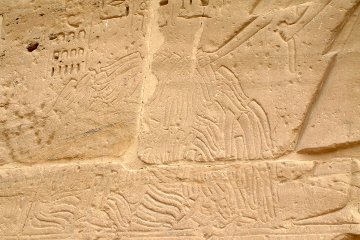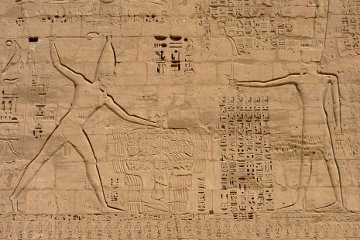The Big Hand Mystery at Avaris
There's a rather gruesome story in the Bible about how David won his bride, a girl called Michal. Apparently he had father-in-law trouble: his father-in-law wanted him dead! The result was that when David came and asked for the girl's hand, the father, King Saul, assured him that he didn't want any money as a dowery. Instead he wanted David to do what David did best and fight against Saul's enemies the Philistines. "Bring me a hundred foreskins", the King James Version somewhat coyly puts it.
Saul's idea was that somewhere along the way, one of the Philistines would get lucky and land David a mortal blow, but in fact it was David who was lucky. He went off with his band of warriors and brought back double the required number.
"Wherefore David arose and went, he and his men, and slew of the Philistines two hundred men; and David brought their foreskins, and they gave them in full tale to the king, that he might be the king's son-in-law." 1 Samuel 18:27
Given that the Jewish ritual of circumcision involves the removal of the foreskin, it might appear that David was actuated by the missionary spirit and simply compelled two hundred of the Philistines to become Jews. If that was all that happened, the Philistines could have counted themselves as extremely lucky!
The temple of Medinet Habu in Egypt is famous for its wall reliefs in which Pharaoh Rameses III boasts of how he defeated the Peoples of the Sea when they attempted to invade Egypt. Inside the second pylon there is a courtyard decorated with reliefs of battles and victories, but if you turn right you immediately see a picture of Egyptian scribes standing beside a waist-high pile of severed hands. The hieroglyphs beneath the relief record just how many hands had been taken.
This it appears, was an old Egyptian custom. Ahmose son of Ibana, who left a long and boastful tomb inscription describing the part he played in the reconquest of Egypt from the Hyksos records on occasion when he was awarded the "Gold of Valour": "Then I fought hand to hand. I brought away a hand. It was reported to the royal herald." In a subsequent battle in Nubia he came away with three hands and got "gold in double measure"!
It would seem, therefore, that successful warriors proved their courage and their success by chopping off the hands of the enemies they killed and bringing them back to be added to the pile the scribes were counting. It seemed like a foolproof method, until large numbers of Egyptian dead started to turn up with their right hands missing!

| |
| A scribe counts a waist-high pile of proofs that the enemy is dead. |
A second panel therefore shows the scribes counting a pile of curious objects, a pile to which soldiers are adding more of the same objects. Egyptian art is not known for its realism, so it usually takes members of our tour groups a few minutes - and not a few hints - to identify these objects, which look like floppy sticks with a couple of knobbly bits at one end.
You see, the Egyptians were circumcised and the relief makes it very clear that the Philistines were not. There was one very simple way, therefore, of ensuring that the trophies brought to the scribes were from defeated Philistines, not from Egyptian casualties, and at the same time providing a strong indication that the victim was dead, not just wounded!
Assuming that David was following this Egyptian practice, it would appear that "foreskin" is a euphemism and that his Philistine victims were deprived of rather more than a bit of redundant skin!
Archaeologists have now found evidence that the practice may not have originated with the Egyptians after all.
A team from the Austrian Academy of Sciences and the Austrian Archaeological Institute, directed by Manfred Bietak, have been working at the ancient site of Avaris, the Hyksos capital in Egypt, now known as Tel el-Daba. Their latest project has been the excavation of a large building that is probably the royal palace. One of the larges rooms in this structure has been identified by the archaeologists as the throne room.
Naturally, when excavating a room, you are alert to any discolouration in the earth, which may represent a pit dug to support a wooden pole that held up the roof or may even be a rubbish pit into which the careless housewife swept the bones and bits of broken pottery that would otherwise have made the house untidy. The excavators found two such bits of discoloured soil and proceeded to excavate them with particular care.

| |
| One of the hands emerges spookily from the earth which has hidden it for 3,600 years. |
To their astonishment, each pit held a human hand - a right hand at that. What is more, the hands were particularly large hands, implying, of course, that the possessor of that hand had been particularly large!
That was surprising enough, but later on the archaeologists found another two pits - in other rooms of the palace - and these contained a further 14 hands; again, all right hands and all large hands, a couple of them particularly large hands! The obvious interpretation is that these are the hands of enemies slain in battle and brought before king Khayan for reward.
The problem is that a battle which resulted in a mere 16 deaths wasn't really a battle at all, more a vicious little skirmish and unless there was some factor about which we know nothing, it seems strange that it should have merited being brought to the attention of the king himself.
One factor, of course, might be that Khayan himself had been responsible for these deaths and that these were the trophies he had garnered himself on the field of battle. If so, given the size of his opponents, one can only take off one's hat in respectful admiration for a man who must have been a peerless warrior!

| |
| In this relief from Medinet Habu Rameses III stands before Amun. He is about to club to death the group of prisoners he is holding by the hair. |
Or can one? Numerous Egyptian reliefs depict the victorious pharaoh in the act of clubbing some unfortunate prisoner to death. Indeed, some of these reliefs show the gigantic pharaoh holding a group of a dozen or more tightly bound prisoners by the hair while he raises a club menacingly over his shoulder. It is believed that the reliefs depict a ceremony in which the leaders of a defeated enemy are brought before Amun and clubbed to death as an offering. There is no doubt that in early times the men were actually killed, but those who like to see the Egyptians a kindly sages claim that later on it was merely a ceremony in which the victims were threatened with a club but not really put to death.
The fact that all these hands are extraordinarly large indicates to me that these were enemies remarkable for their size, preserved for that reason and brought before Khayan in his palace. No one has ever suggested that the Hyksos were kindly sages and it is highly likely that Khayan put his club to good use, seizing the bound prisoners by their hair and smashing their skulls with a good deal of glee. And then, as evidence of his prowess, their hands were cut off and buried, some in the royal throne room and the rest elsewhere in the palace.
Bietak talks about how cutting off the dead enemy's hand would ensure that he was helpless in the afterlife, but that is just his interpretation. Presumably the Egyptians discounted the possibility of vengeful left-handed ghosts stalking their palaces. There are no Egyptian texts which would lead us to think that the Egyptians shared Bietak's opinion and all the evidence is that the practice was used simply as a way of measuring enemy casualties.
Which brings us back to David and his men, gleefully marching back to Saul's palace brandishing the blood-stained evidence of their valour. Saul intended it as a trap, but in view of the undeniable evidence of David's courage and enthusiasm he had no choice. David got the girl.
Peoples of the Sea The exact origin of these "Peoples of the Sea" is unknown. The usual interpretation is that they are the Philistines arriving on the scene of action for the first time in history. The Bible reports that the Philistines came from "Caphtor" or Crete and the Peoples of the Sea are credited with a wide swathe of destruction along the shores of the Mediterranean, including the extinction of the Hittites.
Some have even suggested that the Philistines are, in fact, the Minoans, driven out of their homeland by the catastophe of the eruption of Thera/Santorini. According to this theory, the Minoans transported themselves by ship to Turkey and marched along the coast in sufficient numbers to overwhelm the Hittites but then, instead of occupying the Hittites lands, they carried on down into Palestine and from there attempted the invasion of Egypt where Rameses III famous defeated them in a climactic battle in the Delta.
In the Medinet Habu reliefs the Peoples of the Sea are shown travelling in a convoy of wagons and accompanied by their wives and children. The archaeological evidence shows that the Hittites, Ugarit, Ashkelon and Hazor were all destroyed about this time. However it is only guesswork that the Philistines were responsible.
Other possible identities for these "Peoples of the Sea" include Mycenaean Greeks, defeated Trojans, Lydians or other people from Anatolia affected by a famine, or possibly even some unknown race perhaps coming from the steppes of Russia or from among the tribesmen of the Caspian Sea. Velikovsky, who firmly believed that Rameses III has been misdated by some six hundred years, argues that in fact they are the Greeks whose meddling in Egyptian affairs ended in disaster. Others point to the headdresses depicted in Medinet Habu and link them to the Persian headdresses shown at Persepolis. The plain fact is that we simply do not know. Return
a foolproof method It was, I suppose, possible to cut off someone's hand but leave him still alive, so Assyrian reliefs show their soldiers coming before the king holding the heads of slain enemies. Yet even this was not an infallible proof of valour, because the relief also shows one soldier, who presumably had been less than forward in the battle, harvesting a head from a bound prisoner so that he might join the grisly procession heading for royal reward. Return
© Kendall K. Down 2012





